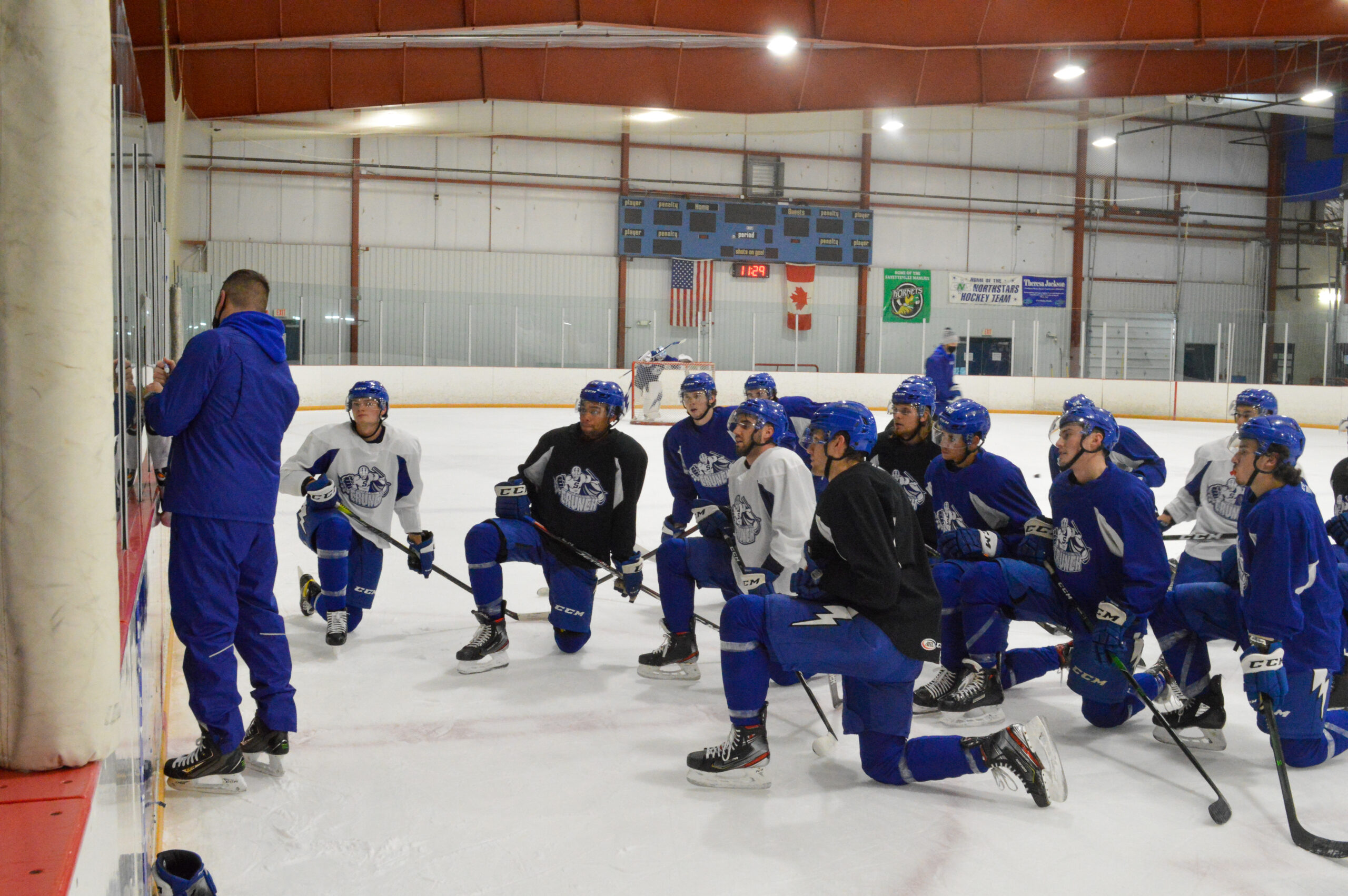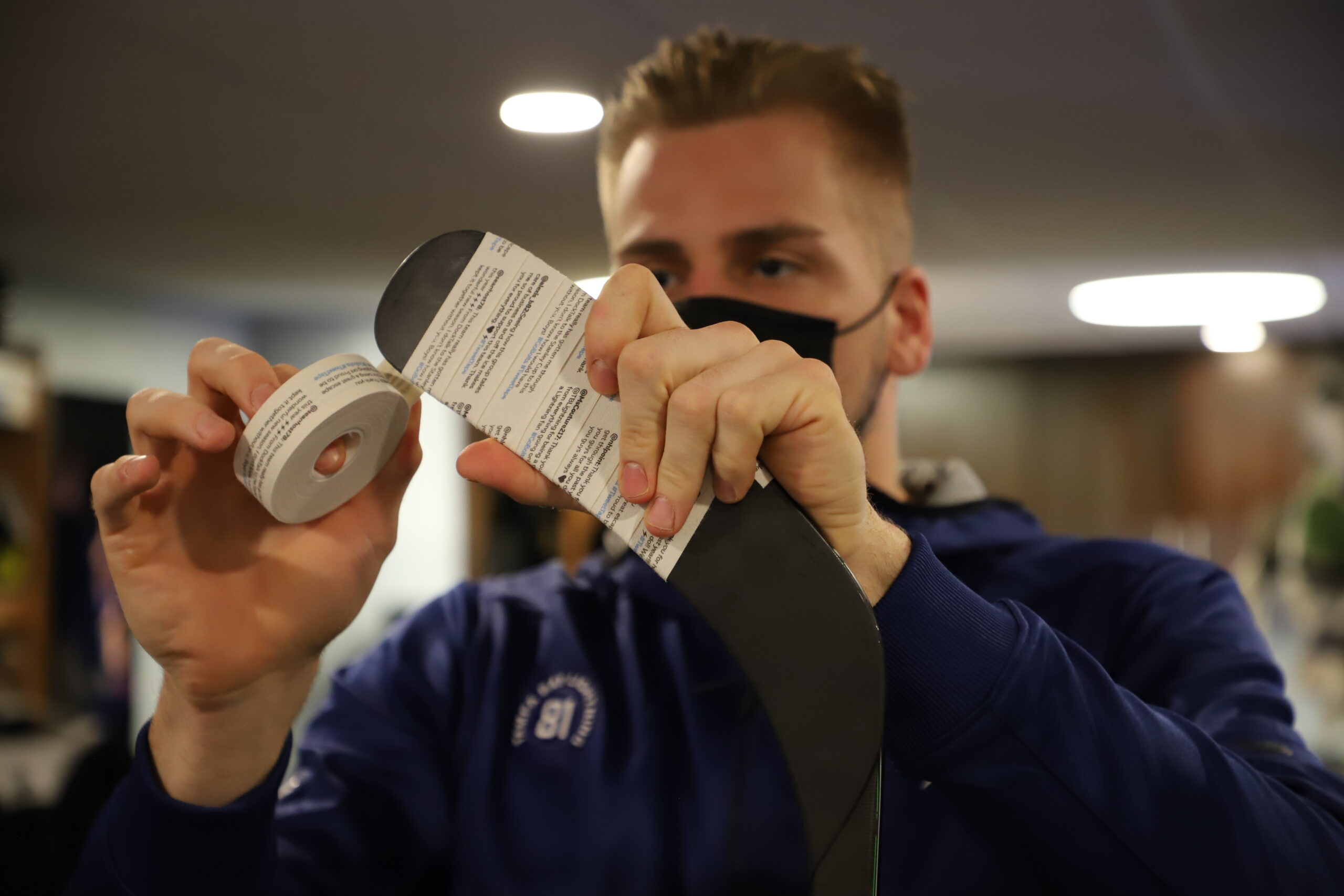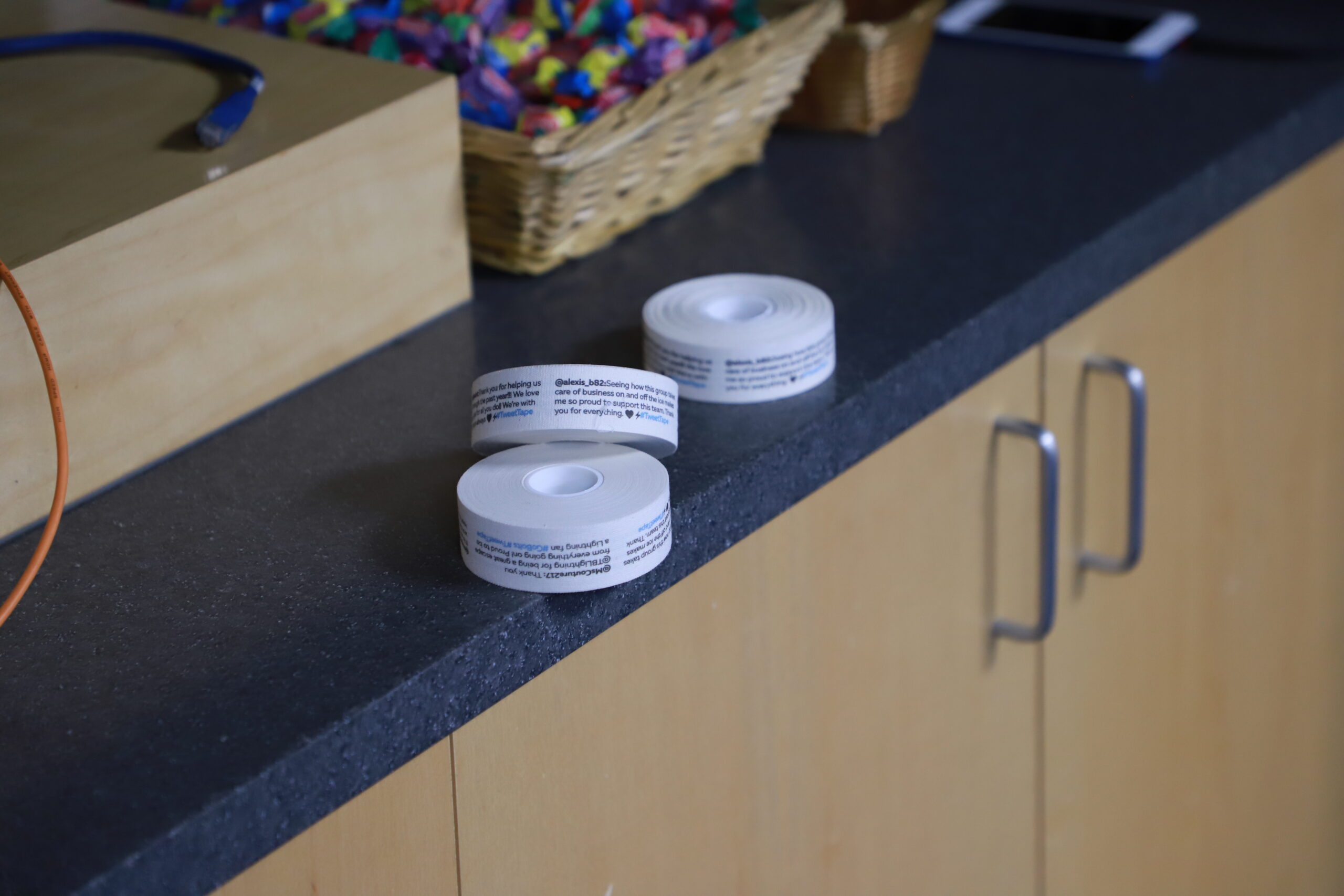Behind scenes of the Lightning development process, #TweetTape and a club record

By Joe Smith Mar 24, 2021 (from The Athletic)
Ben Groulx gathered his team together Friday morning in their makeshift video room, which is essentially the basement of the War Memorial Arena in downtown Syracuse.
Players for the Lightning’s AHL affiliate, the Syracuse Crunch, sat in chairs spread several feet apart. There were three TVs, with one big screen in the middle. Groulx, 53, started the session with a clip from the previous night’s Lightning game, a 4-2 victory over the Blackhawks. Showing the team’s NHL affiliate is nothing new of course — why not use the Cup champs as the model?
But there was a very familiar face on screen. It was rookie Ross Colton, who had sat in those same chairs next to them just a few weeks earlier. Groulx showed the clip of Colton’s second career NHL goal, where the center blazed through the neutral zone off the rush and finished a breakaway.
The Crunch coaching staff has often shown video of Anthony Cirelli, Yanni Gourde and Brayden Point. Now it was Colton, and it really hit home. You’re this close.
After Colton’s goal, Crunch players cheered.
“I think the best salesmen on the team are your former players,” Groulx said. “The one who went through it before him. Yanni was here, so was Cirelli, I think those guys are a great model for anyone playing in Syracuse. This time, it was Ross. When you talk about having speed in the neutral zone, something we’ve talked a lot about with our team, what’s better than one of your players that just got called up and scoring a goal in the NHL?”
With a perennial salary cap crunch, the Lightning will have to rely on the Crunch more than ever. GM Julien BriseBois has said the best way to find good players is to develop them, and Tampa Bay has been a really good example of how much of a difference it can make. Colton became the 63rd former Crunch player to play for the Lightning since their affiliation began in 2012-13, and these are not all fringe guys.
You’re talking about Cirelli and Gourde. Tyler Johnson, Ondrej Palat and Alex Killorn all won a Calder Cup in the AHL before debuting with the Lightning. Nikita Kucherov had a cup of coffee with the Crunch. Erik Cernak got the needed polishing before becoming a shutdown defenseman. Andrei Vasilevskiy played in Syracuse as he was getting groomed to take over for Ben Bishop. Rookie defenseman Cal Foote spent two full seasons in Syracuse before locking down a regular role in the third pair this year. It’s where Mathieu Joseph found his way back after a humbling demotion to Syracuse at midseason last year.
Everyone wants to know, what’s the secret sauce in Syracuse? As someone who has made annual trips up there, it’s easy to see why there’s a multitude of factors. It starts with the drafting process, led by scouting director Al Murray, where they pick players that fit their identity. There’s a philosophy of not rushing prospects, dating back to Steve Yzerman’s days as GM, and that includes encouraging players to stay in college if need be.
And then there’s the laboratory in Syracuse, led by a future NHL coach in Groulx and an expansive support staff, from assistants to skating coaches like Barb Underhill, skills coach Mike Ellis and mental performance coach Ryan Hamilton. There’s a synergy between Syracuse and the Lightning, not necessarily in their systems, but in their habits and structure, which is why you’ve seen several players successfully make the jump this year, from Foote and Colton to Alex Barre-Boulet and, soon, Taylor Raddysh. Coach Jon Cooper said it’s a “meritocracy,” so those who earn their shot get one.
“The way they operate up there and down here is the same thing,” Barre-Boulet said from Syracuse, where he returned after a two-game stint in Tampa Bay. “They don’t accept minimum effort. They want you to go hard every time. Whether it’s one-on-one drills, or other drills that get you ready. If you miss it, you’re going to do it again.
“When guys get the call, they’re ready to go up there and play.”
The NHL Draft can be an inexact science and no team, including the Lightning, is perfect.
But they have a really good idea of the characteristics in players they want, whether that’s in the draft, free agency or trade. And that’s where this development process starts, finding guys who would fit in their culture. It’s how they’ve struck gold on the second days of the draft in plucking Point and Cirelli in third round, and Palat in the seventh. BriseBois said in every player they’ve brought in over the years, they’ve asked one key question:
“Is he a Bolt?”
Well, I once asked BriseBois, what is a Bolt?
“He’s able to play fast, which is a combination of skating and anticipation, having the technical ability to make plays at high speed,” BriseBois said. “It’s making a good pass, getting shots off. High character people. We want good guys, ideally we want guys with a growth mindset. Every day, they try to improve as a hockey player and represent the organization well, someone fans can be proud of.”
They felt Colton, for example, had those qualities when drafting him in the third round in 2016. The son of a nurse and middle school teacher had racked up 35 goals in the USHL, but needed time to mature, which he did at the University of Vermont; he became an instant leader who “hated to lose,” according to his coach. The Lightning didn’t pressure him to leave, but Colton went pro after two seasons, knowing he had some work to do.
That’s where the development process came in.
“I remember his first year here, he was dying after 20-25 seconds,” Groulx said. “The skating was not adequate for him to be a good player at our level. His first year was a real eye-opener for him.”
Colton took the constructive criticism and worked at it, with his conditioning from his first to second year improving “100 percent,” Groulx said. It was a group effort, from working with Crunch strength coach Mark Powell and Underhill to getting support from assistants like Gilles Bouchard, Eric Veilleux and Ken Klee.
Colton gave a lot of credit to Groulx and the Crunch staff.
“As a coach and a person, he gets the most out of you,” Colton said. “The last two years, he made me into a different player that I didn’t know I could be. He forced me to play a different way.”
Colton said Groulx told him to “be like Yanni Gourde.” They weren’t exactly the same players, but both were energy-drivers who played center, and that gave him a model to follow. The Crunch staff didn’t make Colton into someone he wasn’t, preferring to teach him the kind of habits and skills he’d need to succeed at the next level. They talked about being first on the puck, about using their stick well, about taking a hit to make a play.
Then Groulx would show Crunch players video of Gourde and Cirelli doing exactly that.
“It’s a great example of things you need to do if you want to go to the NHL,” Barre-Boulet said. “Look at Gourde and Cirelli, they always win one on one battles, their forecheck is incredible. They do the little things that make a great player — blocking shots, getting stick on puck, things that people don’t see. Fans see the highlight-reel play, but sometimes it was the forecheck by Tony or Gourde that turned the whole thing. It makes you want to do those things to get to the next level.”
You know what they say about players being the best salesman.
“Your coach can tell you something,” Barre-Boulet said. “But when you can back it up with video, it’s hard not to believe.”
When the Lightning drafted Foote in the first round in 2017, it was easy for fans to get excited.
There’s usually a dearth of right-shot defensemen on the blue line, so every fall there were questions on when Foote would be ready to make the jump? But Tampa Bay didn’t rush their top defensive prospect, who played in 144 AHL games before making his NHL debut this season. He’s now played in 17 straight games, showing the ability to be a regular on the third pair.
“Patience is key,” said Lightning assistant GM Stacy Roest. “The players will tell you when they’re ready to play.”
It’s not just Foote. Colton played in 131 pro games before getting his first taste of the NHL. Barre-Boulet has played 137, back in Syracuse after a several week stint with Tampa Bay and their taxi squad. Gourde played 215 games for the Crunch, nearly 300 pro games if you include his time with the Sharks AHL team. Even Palat played 127, Johnson 137. Cirelli needed just 54.
“When a player reaches the NHL, a lot of things have to go right,” Groulx said. “But I also think a key part of anything is having the resources and using them properly. And the biggest part is still the players. They’ve got to understand what he has to do, commit to it and believe and never stop until he reaches it.
A few weeks ago, Groulx started a team video session with 10 clips from Cirelli. None of them involved goals. They were all focusing on puck pursuit, forechecking, compete. In Groulx’s mind, you need to be able to execute the fundamentals to not only reach the next level but earn the trust of coaches like Cooper. That’s why Groulx uses video as examples, whether it’s Lightning players, others in the NHL like Columbus defenseman Seth Jones or other athletes like Michael Jordan and Wayne Rooney. Groulx said Cooper and the Lightning assistants play a strong role too in preparing prospects for their first game and putting them in the right situations (Barre Boulet played with Gourde in his debut, and got some power play time too).
Cooper, who won a Calder Cup with the Lightning’s AHL team in Norfolk, knows what it’s like. He said there’s a lot of synergy between the two programs.
“The underlying philosophy is the same,” Cooper said. “You believe in the players, what type of players you have, everyone has an understanding in this organization that there’s a clear path to go from the AHL to the NHL. A lot of it has to do with the player, if they follow the guys that come before them and what coaches talk about in the AHL.”
Behind the #TweetTape

The Lightning have tried to find creative ways to connect with fans while apart, with the best example the pane of glass signed by supporters that they brought with them to the bubble last season.
But on March 18, they delivered another special surprise.
The organization had collected messages from fans via Twitter, and had them printed on stick tape for use in one game against the Blackhawks. Players like Sergachev, Blake Coleman, Cernak and Mathieu Joseph proudly wrapped them around their stick blades.
How did the Lightning pull it off? It’s actually a cool story, which included a Islanders fan.
The organization’s marketing team was in a preseason meeting, going over different ideas, when the creative agency they’ve partnered with, Dunn & Co, offered the tweet tape suggestion. It had been done before on Super Bowl confetti a few years ago.
“I’m like, ‘Do you know if that’s possible?’” said Brittany Austin, the Lightning’s director of creative and brand strategy. “And they’re like, ‘That’s your job!’”
About a month ago, the Lightning put the request for fans’ messages from their main Twitter account. Austin said there quickly were around 200 responses, with a great mix of messages. “We wanted it to be positive,” Austin said. “Social media is not always the most positive of places.”
The Lightning picked a handful of messages to use. They just needed a printer.
They found one in Andy Machover, a 65-year-old Brooklyn native who co-owns a printing company, Tape-Rite, with his brother Geoff. Machover, a proud University of Miami graduate, used to be a geologist for a Texas oil company but joined the family business in the late 1970s when the oil industry struggled. The tape printing business, however, has gone well. Ninety-nine percent of the jobs are for clothes and boxes, but there have been some sports-related tape printing over the years, from a Nickelodeon athletic event 10 years ago to CrossFit. They had provided tape for high schools and other programs, but nothing for the major pro sports. That changed when the Lightning called.
The whole process, from order to delivery, ended up taking just a week. The Lightning sent the artwork through a PDF and Machover used flexography to execute (wrapping a printing plate around a cylinder, which imprints tape as it passes underneath). Tampa Bay ended up with 100 rolls of tape, the minimum order, but plans to distribute them to their youth hockey programs (another surprise is coming for fans whose tweets were picked). It cost around $900 overall, but to the fans who saw their tweets on players’ sticks, it was priceless.
“It literally made my day that day,” said Lightning fan Sarah Couture. “I kept trying to figure out if it was on anyone’s stick who scored that night because that would have been even cooler to know!”

Game observations
• Andrei Vasilevskiy made history, setting a franchise record with his 12th straight victory in Tampa Bay’s 2-1 win on Tuesday. It’s an incredible achievement, especially when you consider this is the third streak in his career of 10 wins or longer (only Hall of Famer Martin Brodeur has more with four). Gourde said Vasilevskiy has been their best player since the start of the season — an MVP candidate in my eyes — carrying the confidence from his Stanley Cup championship.
“He’s a cornerstone goaltender for us,” Cooper said. “He just continues to amaze. To have that consistency — this isn’t a flash in the pan where, ‘Wow, he got on this lucky run.’ He’s done this before. It’s rightful he should be the guy that holds the record with the Tampa Bay Lightning, he’s had such an impact on the organization since the time he’s been here.”
• But this was one of Tampa Bay’s better defensive performances of the season, holding the Stars to just seven shots through two periods (including just one in the second). Vasilevkiy said he wanted to thank his teammates for that, and their part in his record.
“It was probably one of the best games we’ve ever played,” Vasilevskiy said. “So one of the easiest games I’ve ever played. Just really proud of our team. Just unbelievable effort. Only seven shots against in the first two periods — that was amazing and never happened to me before.”
After being a little loose defensively in some of their recent victories, this Tampa Bay win had more of the template they used in the bubble on their Cup run. “Guys were committed to defending and hence that’s how you win 2-1 games,” Cooper said.
• Man, hockey players are crazy tough. Cernak took a shot off a place on the knee with no padding, came out and then returned soon after. Roope Hintz looked like he was done for the season after falling on his legs awkwardly, then getting carried into the lockeroom, but then came back moments later. And then there was Mikhail Sergachev, who took an errant Vasilevskiy clearing attempt off the face. He went to the room to get blood cleaned off and likely some stitches. Vasilevskiy apologized postgame.
Both seemed to have a good sense of humor about it.
“Just trying to put it on the boards and Sergy’s face was in the way,” Vasilevkiy said. “I apologized already. Obviously it’s not good for the team or his face, but it happens.”
• The Lightning were already shorthanded defensively with Ryan McDonagh missing the game due to a lower body injury suffered Sunday. Cooper said they hope McDonagh will play on this three-game road trip, which ends Saturday in Carolina, but didn’t sound optimistic. At least it doesn’t seem like it’s a serious injury, which the Lightning can ill afford.
• McDonagh’s injury allowed Andreas Borgman an opportunity to play in just his second game of the year (and 50th in the NHL). Borgman looked pretty good, too, playing with confidence and poise, earning the coaches’ trust to play 14 minutes, 13 seconds alongside Foote on the third pair.
“He played really well,” Cooper said. “He skated well, was up in the play, made great outlet passes. It’s tough to play when you’re not playing and constantly practicing, not getting a whole lot of game action and then play a quality opponent. But he just kept it simple and when you usually do that you have success.”
• Yanni Gourde had a goal for the fourth straight game, giving him 12 in 32 games this season (already more than the 10 he had in 70 last year, when he went through a two-month goal drought). It doesn’t even seem like the same player confidence-wise offensively.
(Top photo: Courtesy of Syracuse Crunch)
